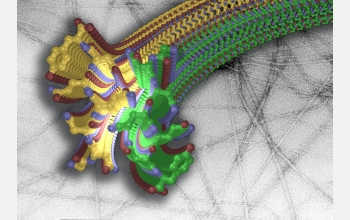|

Press Release 05-095
Zipped Structure May Explain Protein Clumping in Brain Disorders

Finding may provide insight on Alzheimer's and Huntington’s disease
June 8, 2005
After years of intense work, researchers have discovered the 3-dimensional structure of a miniscule--yet mighty--region of a protein that forms deleterious rope-like structures in the brain. Known as amyloid fibrils, the proteins are associated with the degenerative brain disorders Alzheimer's, Parkinson's and Huntington's diseases, and so-called prion diseases like mad cow. This particular region of the protein catalyzes the formation of a "molecular zipper," which pulls proteins together to form the stubbornly stable clumps.
Knowing the structure will help researchers devise new treatments for the more than two-dozen human diseases associated with fibrils, which are attributed to killing neurons and other types of cells. Effective therapeutics may reverse the zipping to break down persistent fibrils or prevent them from forming in the first place.
The work appears in the June 9 issue of the journal Nature.
By studying a specific yeast protein that aggregates similarly to the fibrillar proteins associated with animal diseases, David Eisenberg, his team at the University of California, Los Angeles (UCLA), and international colleagues determined that a region of these fibril-forming proteins forms two sheets that "zip together." This coupling--occurring along a self-guided track--squeezes out water molecules to form a dry, persistent structure that helps account for the tenacity of fibril build ups.
This abnormally dry, zipped-up protein is completely insoluble, that is, it does not dissolve in water, which is a hallmark of amyloid fibrils. In people with Alzheimer's disease, for example, the build up of fibrils in the brain is commonly referred to as plaque.
After years of solo work on the protein's structure, Eisenberg teamed with Christian Reikel, an expert who studies the crystal structures of small-scale molecules at the European Synchrotron Radiation Facility. Using a technology that allowed them to "see" the protein's 3-dimensional structure, the combined group is the first to document the molecular structure of a fibril--a feat that has eluded researchers for decades.
This research is supported by the National Science Foundation, the National Institutes of Health, the Howard Hughes Medical Institute and the U.S. Public Health Service.
-NSF-

Media Contacts
Richard (Randy) Vines, NSF (703) 292-7963 rvines@nsf.gov
Principal Investigators
David Eisenberg, University of California, Los Angeles (310) 825-3754 david@mbi.ucla.edu
Related Websites
For a complete story, see the UCLA news release at: http://newsroom.ucla.edu/page.asp?RelNum=6197

The National Science Foundation (NSF) is an independent federal agency that supports fundamental research and education across all fields of science and engineering. In fiscal year (FY) 2009, its budget is $9.5 billion, which includes $3.0 billion provided through the American Recovery and Reinvestment Act. NSF funds reach all 50 states through grants to over 1,900 universities and institutions. Each year, NSF receives about 44,400 competitive requests for funding, and makes over 11,500 new funding awards. NSF also awards over $400 million in professional and service contracts yearly.
 Get News Updates by Email Get News Updates by Email
Useful NSF Web Sites:
NSF Home Page: http://www.nsf.gov
NSF News: http://www.nsf.gov/news/
For the News Media: http://www.nsf.gov/news/newsroom.jsp
Science and Engineering Statistics: http://www.nsf.gov/statistics/
Awards Searches: http://www.nsf.gov/awardsearch/
| 

